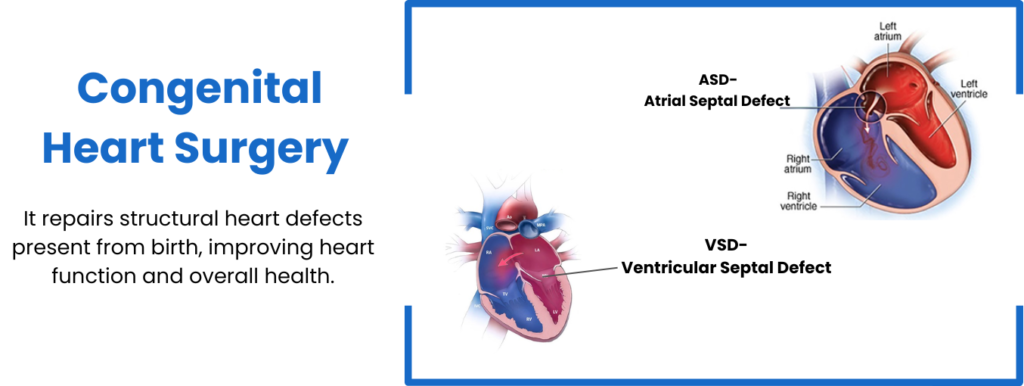Congenital/Paediatric Heart Surgery

Understanding Congenital Heart Defects
Congenital heart defects are structural problems with the heart present from birth. They can affect the heart’s walls, valves, and blood vessels. Among the most common congenital heart defects are atrial septal defects (ASD) and ventricular septal defects (VSD).
➤ Atrial Septal Defect (ASD)
ASD is a hole in the wall (septum) that separates the top two chambers of the heart (atria). This hole allows oxygen-rich blood to mix with oxygen-poor blood, causing the heart to work less efficiently. If left untreated, ASD can lead to complications such as heart failure, stroke, and pulmonary hypertension.
➤ Ventricular Septal Defect (VSD)
VSD is a hole in the wall separating the two lower chambers of the heart (ventricles). Similar to ASD, this defect allows oxygen-rich and oxygen-poor blood to mix, which can strain the heart and lungs. Untreated VSD may result in heart failure, delayed growth, and recurrent respiratory infections.
➤ Indications for Surgery
While some small ASDs and VSDs may close on their own during childhood, larger defects or those causing significant symptoms often require surgical intervention. Indications for congenital heart surgery include:
- Significant symptoms such as breathlessness, fatigue, and poor growth.
- Heart enlargement or heart failure.
- Risk of complications like pulmonary hypertension and arrhythmias.
➤ Surgical Procedures
ASD Surgery
- Open-heart surgery: The most common method for closing an ASD. During this procedure, the surgeon makes an incision in the chest, temporarily stops the heart, and uses a heart-lung machine to maintain circulation. The hole is then closed with stitches or a patch.
- Catheter-based procedure: For suitable candidates, a less invasive method involves threading a catheter through a vein in the groin to the heart, where a closure device is deployed to seal the ASD.
➤ VSD Surgery
- Open-heart surgery: This is the standard approach for repairing a VSD. The surgeon makes an incision in the chest, and the heart is temporarily stopped. Using a heart-lung machine, the hole is closed with stitches or a patch.
- Minimally invasive surgery: In select cases, smaller incisions and specialized instruments allow for the repair of VSDs with less trauma and quicker recovery.
➤ Recovery and Aftercare
Postoperative care is crucial for a successful recovery. After congenital heart surgery, patients typically spend several days in the intensive care unit (ICU) for close monitoring, followed by a hospital stay to ensure stable recovery.
Recovery tips include:
- Follow-up appointments: Regular check-ups with your cardiologist to monitor heart function and overall health.
- Medications: Prescribed medications to prevent infection, manage pain, and support heart function.
- Activity limitations: Gradually resuming normal activities as advised by your healthcare provider.
- Healthy lifestyle: Maintaining a balanced diet, regular exercise, and avoiding tobacco and alcohol to support heart health.
➤ Benefits of Surgery
Surgical repair of ASD and VSD can significantly improve quality of life by:
- Alleviating symptoms like breathlessness and fatigue.
- Preventing complications such as heart failure and pulmonary hypertension.
- Enhancing growth and development in children.
- Enabling a more active and healthy lifestyle.
Why Choose Us?
Personalized Care: We tailor treatment plans to each patient’s unique needs, ensuring compassionate and comprehensive care throughout the surgical journey.
Advanced Techniques: Utilizing the latest surgical techniques and technologies to ensure the best outcomes and minimize recovery time.
Experienced Team: With extensive training and experience in congenital heart surgery, our team is dedicated to delivering excellence in patient care.
Frequently Asked Questions (FAQs): 👇
ASD and VSD are congenital, meaning they are present at birth. The exact cause is often unknown, but genetic and environmental factors may play a role.
Yes, these defects can often be detected during prenatal ultrasounds.
Small defects may close on their own, and some can be managed with medications. However, larger defects often require surgical repair.
Recovery time varies but typically includes a hospital stay of about a week, followed by several weeks of gradual return to normal activities.
Most patients enjoy a normal quality of life after surgery. Regular follow-ups with a cardiologist are essential to monitor heart health.
